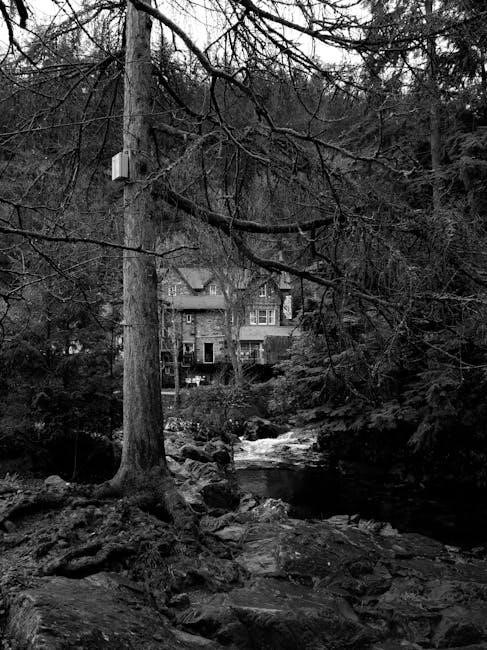Edgar Allan Poe’s The Fall of the House of Usher is a masterpiece of Gothic literature, exploring themes of madness, decay, and the uncanny. Available as a PDF, this story has been widely studied and admired for its haunting atmosphere and psychological depth. Readers can access the tale through various online resources, including versions created by José Menéndez and Lit2Go, perfect for deeper exploration and analysis.
Overview of the Story
The Fall of the House of Usher tells the tale of an unnamed narrator who visits his childhood friend, Roderick Usher, at his family’s ancient mansion. The house exudes an eerie and decaying atmosphere, mirroring the mental and physical deterioration of its inhabitants. Roderick, who suffers from a mysterious illness, believes the house is alive and sentient. His sister, Madeline, is similarly unwell and eventually dies, being entombed in the house. As the story unfolds, the narrator witnesses the unraveling of Roderick’s sanity and the mysterious events surrounding Madeline’s death. The tale culminates in the collapse of the house itself, symbolizing the downfall of the Usher family and their dark legacy. The story masterfully blends horror, mystery, and psychological insight, leaving a lasting impression on readers.
Historical Context and Background
Written by Edgar Allan Poe in 1839, The Fall of the House of Usher is a cornerstone of American Gothic literature. The story reflects the cultural and literary trends of the 19th century, particularly the fascination with death, madness, and the supernatural. Poe’s work was influenced by the Romantic movement and the emerging themes of psychological horror. The tale is set in an unnamed location, creating a sense of timelessness and universality. Its exploration of decay and the “uncanny” resonated with readers of its time and continues to captivate audiences today. The story’s dark atmosphere and intricate symbolism have made it a subject of extensive academic analysis, with numerous PDF versions and scholarly studies available for deeper exploration of its historical and literary significance.
Edgar Allan Poe’s Writing Style
Edgar Allan Poe’s writing style in The Fall of the House of Usher is characterized by its atmospheric intensity and psychological depth. His use of vivid imagery and descriptive language creates a haunting and oppressive setting, drawing readers into the decaying world of the Usher family. Poe employs a dark, melancholic tone, often focusing on themes of madness, death, and the supernatural. His narrative structure, particularly the unnamed narrator’s perspective, adds a layer of mystery and immediacy. The story’s slow-building tension and dramatic climax are hallmarks of Poe’s mastery of the Gothic horror genre. Available in PDF formats, the tale remains a compelling study of his stylistic brilliance and ability to evoke profound emotional and psychological responses in readers.

Themes and Symbolism in the Story
The Fall of the House of Usher explores themes of madness, decay, and isolation, with the house symbolizing the characters’ deteriorating psyches. Available as a PDF, it invites deeper analysis of its haunting elements and psychological complexity.
The House as a Symbol of the Psyche
The house in The Fall of the House of Usher serves as a powerful symbol of the characters’ inner turmoil and psychological decay. Its crumbling structure mirrors Roderick Usher’s deteriorating mental state, while its eerie atmosphere reflects the darker aspects of the human psyche. The house’s “vacant eye-like windows” evoke a sense of lifelessness and despair, aligning with the narrator’s feelings of oppression. The physical decay of the house symbolizes the disintegration of the Usher family’s legacy and the unraveling of their minds. Available as a PDF, the story invites readers to explore how the house embodies the characters’ internal struggles, making it a haunting metaphor for the fragility of human sanity and the inevitability of collapse.
The Theme of Madness and Decay
Madness and decay are central themes in The Fall of the House of Usher, as both the characters and their surroundings spiral into deterioration. Roderick Usher’s mental instability and Madeline’s mysterious illness symbolize the inescapable descent into madness. The house itself, with its crumbling walls and oppressive atmosphere, mirrors the family’s psychological decay. Available as a PDF, the story delves into the unsettling connection between physical and mental disintegration. Poe masterfully crafts an environment where fear, guilt, and despair culminate in the collapse of both the family and their ancestral home, leaving an indelible mark on Gothic literature and horror genres.
The Role of Isolation and Loneliness
Isolation and loneliness are pervasive themes in The Fall of the House of Usher, shaping the lives of its characters and the eerie atmosphere of the story. The Usher family resides in a remote, decaying mansion, far from society, which amplifies their sense of seclusion. Roderick and Madeline’s isolation is both physical and emotional, as they struggle with internal demons and lack external support. The narrator’s arrival briefly disrupts this solitude but ultimately highlights the inescapable loneliness that permeates the house. Available as a PDF, the story underscores how isolation can lead to mental and physical decay, creating an oppressive environment where fear and despair thrive. This theme remains central to the story’s haunting legacy in Gothic literature.
The Concept of the “Uncanny”
The “uncanny” is a central theme in The Fall of the House of Usher, evoking a sense of unease through the blending of familiarity and strangeness. The decaying Usher mansion, with its “eye-like windows,” embodies this concept, appearing both as a living entity and a symbol of the characters’ psychological states. Roderick’s belief in the house’s sentience and the eerie resemblance between the siblings further heighten the uncanny atmosphere. Madeline’s mysterious illness and her eventual return from the dead also contribute to this unsettling duality. Available as a PDF, the story masterfully explores how the uncanny creates fear and discomfort, making it a cornerstone of Gothic horror and psychological intrigue. This element continues to captivate readers, solidifying the tale’s place in literary analysis and adaptation.

Key Characters in the Story
Roderick Usher, the enigmatic proprietor, battles mental decay, while his sister Madeline remains an elusive figure. The unnamed narrator witnesses their tragic unraveling, central to the tale.
Roderick Usher: Character Analysis
Roderick Usher is a central character in Edgar Allan Poe’s The Fall of the House of Usher, embodying the themes of mental decay and atmospheric dread. His fragile psyche and heightened sensitivity make him a tragic figure, unraveling under the weight of his family’s dark legacy. Roderick’s condition deteriorates throughout the story, reflecting the crumbling state of his ancestral home. His relationship with his sister Madeline adds complexity, as their bond is both intimate and oppressive. Roderick’s descent into madness is both fascinating and terrifying, symbolizing the inescapable fate that haunts the Usher family. Available in PDF versions, this tale offers a profound exploration of Roderick’s character and his ultimate collapse.
Madeline Usher: The Enigmatic Sister
Madeline Usher, Roderick’s twin sister, is a mysterious and tragic figure in The Fall of the House of Usher. Her presence is shrouded in an air of secrecy and illness, adding to the story’s eerie atmosphere. Madeline is described as suffering from a mysterious disease, which isolates her further from the outside world. Her relationship with Roderick is deeply intertwined, suggesting an almost supernatural bond. After falling gravely ill, Madeline appears to die, and Roderick entombs her in the family vault. However, her dramatic return during a storm becomes a pivotal and terrifying moment in the narrative. Madeline’s character symbolizes the fragility of life and the inescapable darkness that haunts the Usher family. Available in PDF versions, the story offers a chilling exploration of her enigmatic existence and ultimate fate.

The Narrator: Perspective and Role

The narrator of The Fall of the House of Usher is an unnamed character who visits his childhood friend, Roderick Usher, at his eerie mansion. His perspective serves as the audience’s lens, offering an outsider’s view of the unfolding horror. Upon arrival, the narrator describes the oppressive atmosphere of the house and his growing sense of unease. He observes Roderick’s deteriorating mental state and the mysterious illness of Madeline, Roderick’s sister. The narrator’s role is crucial as he chronicles the events that lead to the tragic collapse of the Usher family and their house. His descriptions of the setting and characters create a chilling tone, drawing readers into the story’s dark world. Available in PDF formats, the tale highlights the narrator’s importance in unraveling the mysteries of the Usher estate; His account remains a vital part of Poe’s enduring Gothic masterpiece.

Plot and Structure
The story begins with the narrator’s arrival at the Usher mansion, where he finds his friend Roderick in a state of mental distress. As the narrative unfolds, Roderick’s psychological deterioration accelerates, culminating in the tragic collapse of both the family and the house. Available in PDF versions, the tale masterfully builds suspense through its eerie atmosphere and dramatic structure.
The Narrator’s Arrival at the House
The narrator arrives at the House of Usher on a dreary, autumnal day, describing the mansion as a place of gloom and decay. Upon entering, he is greeted by Roderick Usher, who appears mentally unstable and deeply troubled. The narrator notices the eerie atmosphere and the sense of impending doom that pervades the house. Roderick expresses his anticipation of the narrator’s visit, hinting at the dark events that will unfold. The narrator is struck by the overwhelming sadness and fear that permeate the mansion, setting the tone for the horrors to come. This scene is vividly captured in PDF versions of the story, allowing readers to immerse themselves in the haunting details of Poe’s masterpiece.
The Deterioration of Roderick’s Mental State
Roderick Usher’s mental state deteriorates significantly throughout the story, driven by his intense anxiety and irrational fears. His condition worsens after the disappearance of his sister, Madeline, as he becomes increasingly unhinged. Roderick’s hyper-sensitive nature and obsessive beliefs contribute to his descent into madness. He exhibits physical symptoms such as trembling and a hollow voice, reflecting his psychological turmoil. The narrator observes Roderick’s erratic behavior and growing paranoia, which culminate in a complete breakdown. This progression is meticulously detailed in PDF versions of the story, offering readers a chilling insight into Roderick’s unraveling mind. His mental decay mirrors the crumbling house, symbolizing the collapse of his sanity and the dark fate that awaits him.
The Climactic End and the Fall of the House
The story reaches its climax as Roderick Usher, overwhelmed by guilt and madness, reveals the shocking truth about his sister Madeline. After her apparent death, Roderick entombs her in the house, but she later returns, leading to a tragic confrontation. The siblings perish together, symbolizing the collapse of their family and sanity. Simultaneously, the House of Usher crumbles, mirroring the destruction of its inhabitants. This chilling conclusion underscores themes of decay and the inescapability of fate. The fall of the house is both literal and metaphorical, marking the end of an era. PDF versions of the story capture this haunting finale, leaving readers with a lasting sense of dread and awe at Poe’s mastery of Gothic horror.

Modern Reinterpretations and Adaptations
Mike Flanagan’s Netflix series, The Fall of the House of Usher, offers a contemporary and chilling reimagining of Poe’s classic tale, blending psychological horror with modern storytelling.
Mike Flanagan’s Netflix Series
Mike Flanagan’s The Fall of the House of Usher series is a modern, chilling adaptation of Poe’s tale, blending psychological horror with contemporary storytelling. Flanagan masterfully reimagines the classic narrative, exploring themes of power, decay, and madness; The series delivers a macabre yet entertaining experience, staying true to Poe’s atmospheric style while introducing fresh elements. It serves as a fitting conclusion to Flanagan’s exploration of Poe’s works, offering a visual and narrative feast. Fans of the original story and newcomers alike are drawn to its unsettling yet captivating portrayal of the Usher family’s unraveling. This adaptation not only honors Poe’s legacy but also brings the story into the modern era, ensuring its relevance for new generations of horror enthusiasts.
Contemporary Reimagining of the Story

Contemporary adaptations of The Fall of the House of Usher breathe new life into Poe’s classic, blending original themes with modern sensibilities. These reinterpretations often emphasize psychological complexity and visual horror, appealing to both long-time fans and new audiences. The story’s core elements—such as the crumbling house and the Usher siblings’ mysterious bond—remain central, but are recontextualized for today’s cultural landscape. Digital formats like PDF and streaming platforms have made these versions accessible, ensuring the tale’s enduring relevance. By merging traditional Gothic elements with fresh perspectives, these adaptations keep Poe’s legacy alive, proving the timeless allure of his dark, haunting narratives. They also highlight how the story’s universal themes transcend time, continuing to captivate readers and viewers in the modern age.

Resources and Further Reading
Access The Fall of the House of Usher as a PDF through platforms like Lit2Go and José Menéndez’s edition. Academic studies and analyses provide deeper insights into Poe’s masterpiece.
PDF Versions of the Story
The Fall of the House of Usher is widely available in PDF format, offering readers convenient access to Edgar Allan Poe’s classic tale. Platforms like Lit2Go and José Menéndez’s edition provide downloadable versions, ensuring the story’s accessibility. These PDFs preserve the original text’s haunting atmosphere and psychological depth, making them ideal for academic studies and personal reading. Fans of Gothic literature can easily find these documents online, allowing them to delve into the eerie world of the Usher family. Additionally, these versions often include annotations and introductions, enhancing the reader’s understanding of Poe’s masterpiece.
Academic Studies and Analyses
Scholarly examinations of The Fall of the House of Usher are abundant, offering deep insights into its themes and symbolism. A notable study in Studies in Short Fiction explores Poe’s theory of the tale, while psychoanalytic analyses delve into the story’s uncanny elements. These academic works, often available as downloadable PDFs, provide critical perspectives on the narrative’s structure and character psychology. Researchers like Hillis Miller and Eric Savoy have contributed significantly to the discourse, examining the tale’s Gothic elements and existential themes. These studies are invaluable for understanding the story’s complexity and its enduring influence on literature and horror genres. Academic analyses in PDF format are easily accessible, making them a valuable resource for scholars and enthusiasts alike.
Recommended Reading for Deeper Understanding
For a profound understanding of The Fall of the House of Usher, readers can explore various PDF resources and analyses. The story itself is widely available in digital formats, such as the version by José Menéndez, which preserves Poe’s original text. Additionally, scholarly articles and essays offer insights into the story’s themes, symbolism, and psychological depth. Works like “The Uncanny in The Fall of the House of Usher” provide psychoanalytic perspectives, while studies by critics like Hillis Miller and Eric Savoy shed light on its Gothic elements. These resources, often accessible as PDFs, are essential for students and enthusiasts seeking to delve deeper into Poe’s masterpiece and its lasting impact on literature.

The Fall of the House of Usher remains a cornerstone of Gothic literature, its haunting themes and psychological complexity continuing to captivate readers. Available as a PDF, the story offers a timeless exploration of madness, decay, and the uncanny, ensuring its enduring legacy in American literature.
Legacy of “The Fall of the House of Usher”
Edgar Allan Poe’s The Fall of the House of Usher has left an indelible mark on Gothic literature and the horror genre. Its exploration of madness, decay, and the uncanny continues to captivate readers and inspire adaptations. The story’s haunting atmosphere and psychological depth have made it a cornerstone of American literature. Available as a PDF, it remains accessible for scholarly analysis and casual reading alike. Its influence is evident in modern reinterpretations, such as Mike Flanagan’s Netflix series, which underscores its enduring relevance. The tale’s ability to evoke fear and introspection ensures its legacy as a masterpiece of dark storytelling, resonating with audiences for generations.
Impact on Gothic Literature and Horror Genre
The Fall of the House of Usher has profoundly influenced Gothic literature and the horror genre. Its eerie atmosphere, themes of madness, and the uncanny have set a benchmark for dark storytelling. The story’s exploration of psychological decay and supernatural elements has inspired countless adaptations, including films, plays, and modern reinterpretations like Mike Flanagan’s Netflix series. Its availability as a PDF ensures accessibility for readers and scholars, further cementing its legacy. Poe’s mastery of evoking fear and unease has made this tale a cornerstone of Gothic horror, shaping the genre’s evolution. Its enduring popularity underscores its ability to captivate audiences, solidifying its place as a foundational text in both Gothic and horror traditions.
